🌍📰 Your source for the latest international news.
Stay informed with real-time updates from around the globe.
#GlobalNews #WorldEvents #InternationalHeadlines
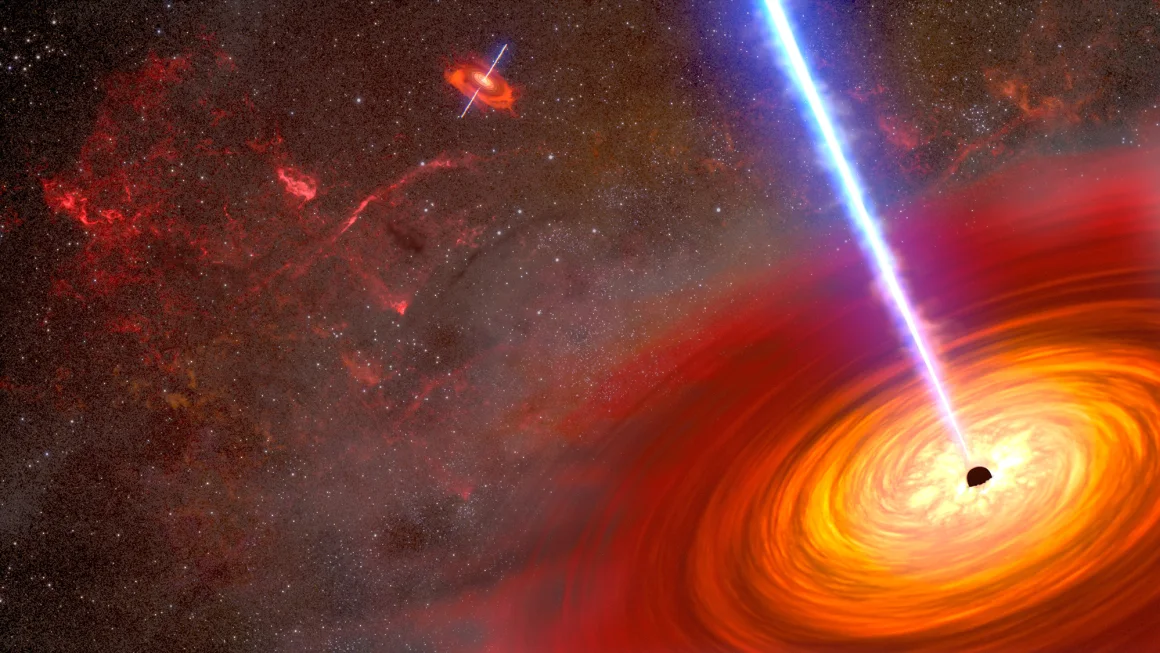
Bright lights detected by NASA telescopes lead to a dancing pair of supermassive black holes
Two telescopes have spotted the closest pair of supermassive black holes to date. The duo, only about 300 light-years apart, were observed in different wavelengths of light using NASA’s Chandra X-ray Observatory and the Hubble Space Telescope.
While black holes are invisible against the dark void of space, these two blaze brightly as the gas and dust they feed on is accelerated and heated to high temperatures. Both celestial objects, which circle around one another, are known as active galactic nuclei.
Active galactic nuclei are supermassive black holes that release bright jets of material and high winds that can shape the very galaxies where they are found.
The black hole duo is the closest pair found through visible and X-ray light. While other black hole pairs have been observed before, they are usually much farther apart. Astronomers discovered these black holes dancing around one another at the center of a pair of colliding galaxies called MCG-03-34-64, which is 800 million light-years away.
Astronomers serendipitously found the black holes when Hubble’s observations revealed three spikes of bright light within the glowing gas of a galaxy. They published their discovery Monday in The Astrophysical Journal.
“We were not expecting to see something like this,” said lead study author Anna Trindade Falcão, a postdoctoral researcher at the Center for Astrophysics | Harvard & Smithsonian in Cambridge, Massachusetts, in a statement. “This view is not a common occurrence in the nearby universe, and told us there’s something else going on inside the galaxy.”
Zooming in on bright cosmic lights
The team was intrigued when Hubble picked up on three optical diffraction spikes in a concentrated region of the MCG-03-34-64 galaxy. Diffraction spikes appear when light from a small cosmic region bends around the mirror inside telescopes.
Hubble’s observations were made in optical light, which is visible to the human eye, but the astronomers weren’t sure what they were seeing. Falcão’s team took another look at the galactic region with Chandra in X-ray light.
When the scientists observed the galaxy using Chandra, they were able to pinpoint two powerful sources of X-ray light that matched the optical light sources spotted by Hubble, Falcão said. “We put these pieces together and concluded that we were likely looking at two closely spaced supermassive black holes.”
The team also consulted archival observation radio wave data collected by the Karl G. Jansky Very Large Array of radio telescopes near Socorro, New Mexico. The black hole duo was also found to release energetic radio waves.
“When you see bright light in optical, X-rays, and radio wavelengths, a lot of things can be ruled out, leaving the conclusion these can only be explained as close black holes. When you put all the pieces together it gives you the picture of the (active galactic nuclei) duo,” Falcão said.
Meanwhile, the third diffraction spike observed by Hubble has an unknown origin, and the team requires more data to understand what it could be. The source of light might be from gas that was shocked by an energetic release of material from one of the black holes.
“We wouldn’t be able to see all of these intricacies without Hubble’s amazing resolution,” Falcão said.
Astronomers have observed pairs of black holes that are closer together than these two through radio telescopes, but those duos haven’t been observed in other wavelengths of light.
Both supermassive black holes once served as the centers of their respective galaxies, but a galactic merger brought the two objects much closer together. Eventually, their close spiral will result in a merger in about 100 million years, according to NASA, causing an energetic release of gravitational waves, or ripples in the fabric of space and time.
Such gravitational waves created by the collisions of supermassive black holes could be detected in the future by LISA, the European Space Agency-led Laser Interferometer Space Antenna mission that’s expected to launch in the mid-2030s.
#universe #news
Read More...
1 year ago
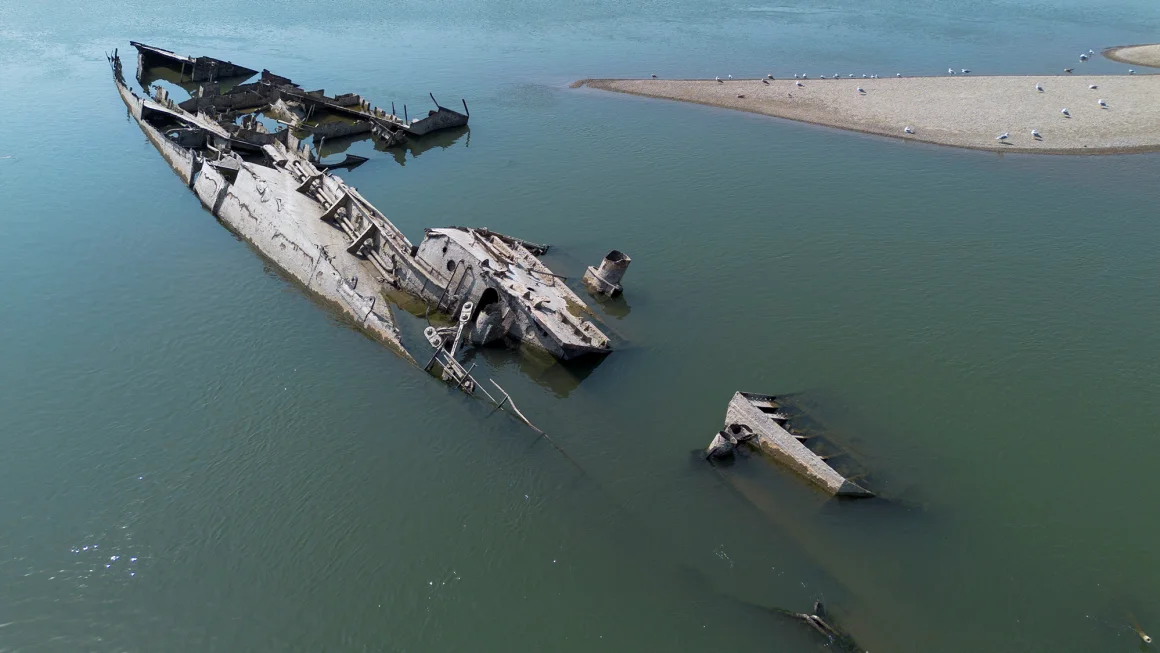
Drought-hit Danube River reveals scuttled German World War II ships
Mohacs, Hungary/Prahovo, Serbia
Reuters
—
The wrecks of explosives-laden Nazi ships sunk in the Danube River during World War II have emerged near Serbia’s river port town of Prahovo, after a drought in July and August that saw the river’s water level drop.
Four vessels dating from before 1950 have also come to light in Hungary’s Danube-Drava National Park near Mohacs, where the Danube’s water level stood at only 1.5 meters (4.9 feet) on Tuesday, the lingering effect of severe heat waves and persistent drought in July and August.
The vessels revealed in Prahovo were among hundreds scuttled along the Danube by Nazi Germany’s Black Sea fleet in 1944 as they retreated from advancing Soviet forces, destroying the ships themselves. The wrecks can hamper river traffic during low water levels.
Strewn across the riverbed, some of the ships still have turrets, command bridges, broken masts and twisted hulls, while others lie mostly submerged under sandbanks.
Endre Sztellik, a guard at the Danube-Drava national park, said of one of the ships, “we still don’t know what this is exactly. What is visible and an unfortunate fact is that the wreck is diminishing as people are interested in it and parts of it are going missing.”
The Danube stood at 1.17 meters (3.8 feet) in Budapest on Tuesday, which compares with an all-time record low of around 0.4 meters (1.3 feet) registered in October 2018. During floods, the Danube rises well above 6 meters (19.7 feet).
“Eastern Europe is experiencing critical drought conditions that are affecting crops and vegetation,” the European climate service Copernicus said on its website in its latest drought report, published earlier this month.
Long-awaited rainfall set in on Monday, which is expected to raise Danube levels to around 3 meters (9.8 feet) at Mohacs by the weekend, with the river likely to submerge the shipwrecks again.
The level of Poland’s longest river, the Vistula, has fallen to a record low, leaving sandbanks exposed in Warsaw and water so shallow a moose was filmed walking across it in a section in the countryside.
#news
Read More...
1 year ago
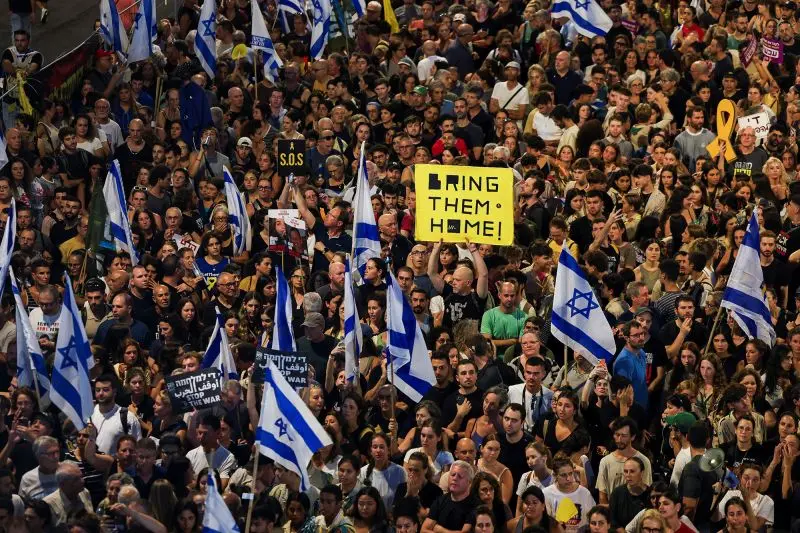
Netanyahu defiant as protesters demanding a ceasefire-for-hostages deal bring Israel to a halt
Hundreds of thousands of protesters took to Israel’s streets in fresh fury on Monday over the government’s failure to secure a ceasefire-for-hostages deal with Hamas. Demonstrations could be seen in Jerusalem, Tel Aviv, Caesarea and other sites across the country, fueled by the killing in Gaza of six hostages, whose bodies were retrieved by Israeli soldiers this weekend.
Several gatherings targeted the homes of Prime Minister Benjamin Netanyahu, with protesters lighting fires and chanting: “You are the leader - you are guilty!” near one of Netanyahu’s private residences in Caesarea. In Tel Aviv, protesters outside the US Embassy chanted “Shame!” late into the evening, video showed.
Netanyahu has been accused of stalling efforts for a deal by some hostage families and their supporters. More than 100 hostages, including 35 believed to be dead, are still being held in Gaza – the vast majority of them taken during Hamas’ October 7 attack on Israel, when some 1,200 people were killed and more than 200 taken captive
The scenes outside the Israeli leader’s homes culminated a day of anger that brought much of the country to a halt, following a call by the country’s largest labor union, known as Histadrut, to shut down the “entire” economy. Flights in and out of Tel Aviv’s Ben Gurion International Airport were also stopped for two hours.
But in a press conference Monday evening, the Israeli leader struck a note of defiance, batting away criticisms – including from US President Joe Biden – that he is not doing enough to secure a deal. He asked for “forgiveness” from the families of the six hostages for failing to bring them back alive, but insisted it should be Hamas that “has to make the concessions.”
He also vowed to retaliate and extract a “heavy price” from the militant group that controls Gaza, for the killing of the six hostages, whose autopsies showed they were shot at short range on Thursday or Friday morning.
Hamas meanwhile escalated its own threats on Monday, with a public warning that more hostages held in Gaza would return “inside coffins” if Israel attempts to free them militarily.
A statement released by the militant group said that its fighters guarding prisoners held in the Palestinian enclave had received “new instructions” on how to deal with hostages if Israeli forces get close, and released an illustrated poster apparently showing hostages threatened with a gun.
Monday saw the largest general strike to have taken place in Israel since March 2023, when there was a similar mass walkout over Netanyahu’s controversial attempts to overhaul the country’s judiciary.
According to union Histadrut, hundreds of thousands of Israelis joined the protests Monday, just a day after half a million took to the streets on Sunday for what protest organizers said was one of the biggest nationwide protests since the outbreak of Israel’s war on Hamas. Israeli police said they had seven demonstrators in Tel Aviv for “violating public order and disrupting traffic.”
‘Netanyahu has made it impossible’
Netanyahu’s defiant stance following the discovery of the six hostage bodies has thrown further doubt on the negotiations for a ceasefire-for-hostages deal.
Even before the killing of the six hostages, the talks had become bogged down, with one key disagreement centering on control of a border area known as the Philadelphi corridor.
Netanyahu says control of the 14-kilometer (8.7-mile) strip of land along Gaza’s border with Egypt is needed to prevent Hamas from resuming arms smuggling through tunnels underneath it. However, the deployment of Israeli troops along the corridor has been a major point of contention between Israel and Hamas in the ceasefire talks, with Hamas saying Israeli troops must withdraw from the border zone.
“Hamas doesn’t want us to be there and that’s why I insist on being there,” the Israeli leader said on Monday.
During a cabinet meeting over the weekend, Israeli Defense Minister Yoav Gallant had lambasted the Israeli government for what he said was prioritizing control of the corridor over a deal to free hostages, calling it a “moral disgrace.”
The relative of one of the hostages who was shot dead in southern Gaza also blamed Netanyahu and his stance on the corridor for their deaths. Gil Dickmann, the cousin of Carmel Gat, told CNN that the Israeli government “cold-bloodedly” crossed a “red line” by prioritizing the corridor over the lives of the hostages.
“We know that Hamas has agreed to a deal at some point, and Israel was the one putting on more and more terms and actually postponing the deal,” Dickmann said on Monday. “Right now, we know the decisions that our Prime Minister Netanyahu has made it impossible for Carmel and other hostages to return and put their lives in great danger, and that’s what killed them.”
But on Monday, even as he acknowledged dissent within his cabinet, Netanyahu doubled down.
“We’re not going to withdraw from the Philadelphi corridor,” Netanyahu told a press conference on Monday evening. “The axis of evil needs the Philadelphi corridor. We need to have it under our control,” he said.
Disagreements over the corridor are only one of the splits within the cabinet over the conduct of the war that have become increasingly public and rancorous in recent months, reflecting deep divisions at the top of Israel’s government.
Just on Monday, Israel’s far-right National Security Minister Itamar Ben-Gvir said he was using his power to prevent a “reckless deal” and ensure “that there will be no negotiations at all.”
He was speaking to members of Gvura, a right-wing organization representing the families of Israeli soldiers killed in Gaza.
But American officials described new urgency in reaching a ceasefire-for-hostages deal. US national security adviser Jake Sullivan said while meeting the families of Americans held hostage that “the next few days will be critical” in the push to free those still held by Hamas.
Alongside the strikes, the funeral of Hersh Goldberg-Polin, one of the six hostages found dead, was held in Jerusalem on Monday. Speaking at the ceremony, Jon Goldberg-Polin said he hoped his son’s death would be “the fuel that will bring home the remaining 101 hostages.”
“Hersh, we failed you. We all failed you. You would not have failed you. You would have pushed harder for justice,” he said. “You would have worked to understand the other, to bridge differences.”
“The 23 years of life that we had with you were a blessing. We now will work to make your legacy a similar blessing,” Goldberg-Polin said. “You were a really great guy. I love you.”
Strike hits public services, schools
As well as an impact on flights, some Israeli municipalities said they joined the strike, including Tel Aviv and Haifa, according to a list from the Histadrut outlining who joined the action as well as statements from some of the cities.
The list also includes government ministries that impact a wide range of public services, the document shows, including parts of the Prime Minister’s Office, the Interior Ministry, and others. CNN has reached out to the Prime Minister’s Office for comment.
Hospitals and healthcare facilities worked on a weekend schedule and on an emergency basis, according to the statement.
The country’s teachers’ union said it would not join the strike, according to a statement from the union, though support staff at schools did.
However, Israel’s biggest universities joined the strike, including the Hebrew University of Jerusalem and Tel Aviv University.
#news #world #breakingnews
Read More...
1 year ago
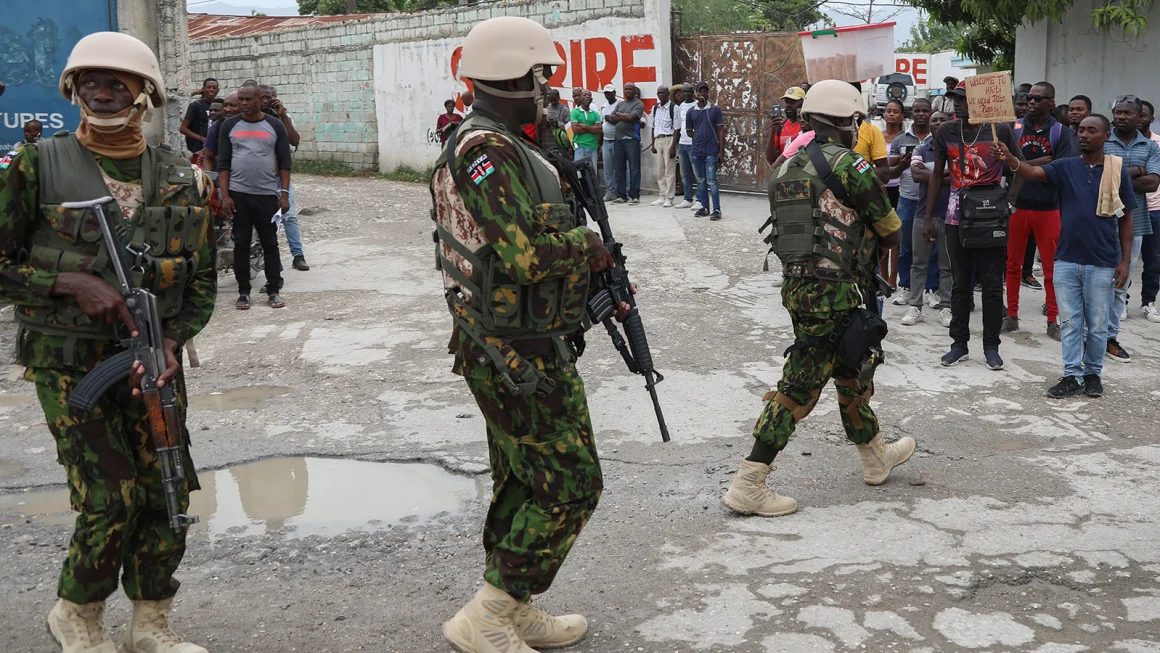
Kenyan police deployed to Haiti haven’t received full promised salary in two months
Hundreds of Kenyan police officers leading an international policing force in Haiti have not received their full pay for two months, the latest complication in what has been a rocky start to the security mission in the gang-plagued Caribbean nation.
The first Kenyan officers deployed to Haiti arrived in June, the vanguard of a multinational security support mission (MSS) that is being funded largely by the United States. There are now around 400 Kenyan police in the country, many from specialized units.
In an August 25 statement acknowledging delays to payments, the MSS announced that officers could expect the missing funds to hit their bank accounts this week.
“Therefore, there is nothing to worry about (regarding) welfare issues of the MSS officers, since mainstream processes have been finalized,” the MSS added.
In a “progress report” released Monday, Kenya’s National Police Service (NPS) said that the officers were continuing “to draw their NPS salaries” while waiting for the supplemental pay for their MSS duties.
Kenyan officers had expected to be paid a significant supplement for their Haiti deployment – a grueling assignment more typical of a military than of a police force. Officers are not allowed to leave their base in the Haitian capital Port-au-Prince during non-working hours.
Speaking to CNN, some officers expressed frustration and concern about the missing supplemental payments. With schools reopening in Kenya this week, some say they need the money urgently to manage school fees and other expenses for their families back home.
“The officers feel frustrated after not having been paid for two months. And we hear that the money has already been sent to Kenya but they haven’t paid us, so please help us out,” one officer in Haiti told CNN before the police statement was released, requesting anonymity.
The MSS force is expected to ultimately grow to 2,500, with more troops expected from Jamaica, Benin, Chad, the Bahamas, Bangladesh, Barbados and Belize. The force is hoped to bolster the Haitian National Police’s battles against an alliance of gangs that controls an estimated 85% of the Port-au-Prince metropolitan area.
Around 600,000 Haitians have been forced to flee their homes due to gang violence, and some 2 million people live in gang-ravaged areas where fear of attack is constant, Haitian interim Prime Minister Garry Conille said in an interview with CNN in early August.
The MSS is financed through a UN-managed trust fund, to which the US, Canada, France and Spain have contributed millions of dollars. The United States has committed at least $380 million overall in support of the mission, largely in the form of equipment and materiel.
Read More...
1 year ago
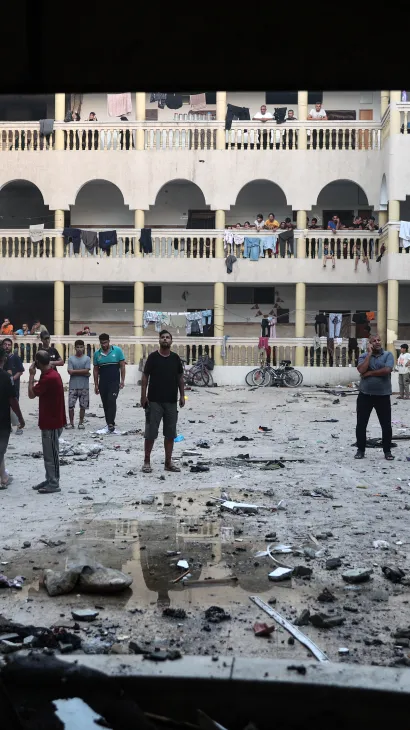
Echoes of a massacre: Tales from Israel's attack on al-Tabin
Al-Tabin School was not the first school in Gaza that Israel has targeted. But medics, journalists and survivors told Al Jazeera that Israel’s August 10 attack on it was the most gruesome massacre since Israel launched its assault on the besieged enclave in October last year.
Israel killed more than 100 displaced Palestinians, leaving victims dismembered, charred and often unidentifiable by their loved ones.
Some 2,400 displaced Palestinians, many exhausted by having been displaced several times, were sheltering in the school in eastern Gaza's Daraj neighbourhood when it was struck by two guided missiles.
The missiles blazed through the upper level, a space that women and children slept and prayed in, to reach the men's prayer area on the ground floor.
Most of the men and boys had woken up to perform the Fajr - or dawn - prayers and were gathered in that space. It was timed for maximum casualties, medics who were there said.
The nearby al-Ahli Arab Hospital - which came under attack months ago and is only partially operational with no burn ward - was overwhelmed as injuries and bodies of slain Palestinians began pouring in.
Throughout the war, Israeli forces have largely kept Gaza’s vital crossings sealed shut, blocking the entry of much-needed fuel, medicine and humanitarian aid to the enclave, where famine is looming.
Al Jazeera spoke to some of the displaced people who survived the attack but lost loved ones, as well as rescue workers and medics who worked in mute horror to save as many people as they could.
Sumaya Abu Ajwa had woken up for the Fajr prayer with her two foster daughters, 16-year-old Nuseiba and 14-year-old Retaj, and their mother.
She and the girls' mother were off to one side when the missiles struck, one of them passing between the two girls, Abu Ajwa told Al Jazeera.
"Suddenly, dust and fire spread everywhere, like it was Judgement Day. I started looking frantically for the girls," she says tearfully, sitting on a bed because she has difficulty walking.
"I found the younger girl [Retaj] and held her in my arms. Her blood was pouring onto my clothes, but I could sense that she was still breathing," Abu Ajwa said, adding that she screamed for help, for anyone to come and save Retaj, but the scene was so chaotic nobody was able to help.
Soon after, Retaj succumbed to her wounds.
The search for Retaj's big sister Nuseiba took longer.
"I went back into the flaming prayer room over and over, looking for her, I couldn't see her anywhere. Then someone told me that she was under the rubble so I went to look where they said.
"When I reached her," Abu Ajwa breaks down, "I found her and her body had been torn in two."
Weeping bitterly, she said she and the girls' mother had done everything they could, through several displacements, to keep the four of them together.
Abu Ajwa had discussed leaving al-Tabin with the girls, but Nuseiba had been reluctant to leave, she said, because she was attending Quran classes there and was proud of her progress in memorising the holy book.
"She told us that if we wanted to leave that was fine, she would stay behind in the school. I told her that I had stayed with them throughout the war and wouldn't leave them now, we'd either make it together or die together, but now they've gone on ahead and left us. They died before us."
The girls only had one wish, she added - for the war to end because they "have been scared so many times, displaced so many times, they were so exhausted and had gone hungry so many times".
The girls have a 14-year-old brother, Abu Ajwa said, who had been taken from them when the Israeli army raided al-Shifa Hospital where they were sheltering at the time.
"The Israelis sent him north on his own. We were very sad then but, who knows, this may have saved him, he's the only hope we have left.
"Who will call me Mama Sumaya now? I crave those words so much," Abu Ajwa sobs.
Suzan al-Basyouni heard the impact first then realised that the school had been targeted, with the mosque hit hardest, and ran to look for her husband who had gone to perform the Fajr prayer.
"The moments of the massacre are etched into my eyes... imagine looking for your husband amid piles of human body parts, to try to identify him and not be able to," al-Basyouni told Al Jazeera.
"Inside the mosque were piles of bodies, dismembered limbs flung around. Those very few who survived were running out of the mosque screaming, in flames.
"I was struggling to get through, stepping on bodies with my own two feet. I stepped on a woman as I was trying to find my husband. I know her, she's a friend of mine and I didn't realise that I was stepping on her. She was at the mosque's entrance."
The dark made it hard for al-Basyouni and her family to find her husband and it was only when the sun rose and rescue efforts advanced a bit that they found him under a pile of bodies.
"His legs had been blown off and his abdomen torn open. He had been martyred alongside his father.
"My solace, my only hope now is that we will find ease in heaven. There is no life left to live in Gaza, we had no idea how horrific life could be and now we know that it's all over.
"There will be no earthly justice, how could there be when we live in Gaza and nobody has moved to help us? Justice will be served by God alone."
Vascular surgery consultant Tayseer al-Tanna stood in shock in the hospital corridor, recounting what he saw after the attack in a voice he was trying to control.
"I deal in science," he said. "So, I try to use my head more than my heart when it comes to treating people.
"But that day, what I saw and what I had to do, I was working with a vice gripping my heart. Yet I kept working, I couldn't stop."
The severity and sheer number of injuries he encountered have left a lasting impression on al-Tanna.
"The burns were unlike anything I’ve seen before, covering 50...70... up to 90 percent of the victims' bodies. Many lost limbs, and so many died in surgery because their injuries were so severe," he said.
Al-Tanna used to work at al-Shifa Hospital and is now the only vascular surgeon remaining in northern Gaza, working out of al-Ahli Arab Hospital where he receives cases from all over the north.
Al Jazeera Arabic’s Anas al-Sharif was among the first journalists who reported on the direct aftermath of the attack.
"I wasn’t prepared for what I saw. The number of martyrs was beyond anything I could have imagined," al-Sharif said.
"There were bodies and limbs outside the school, but nothing could prepare me for the scenes inside. I documented what was happening outside the school and kept going.
"But when I got to the mosque that had been targeted, I was so shocked that I had no words left any more," he recalled.
"I was walking over the bodies of martyrs without realising it. A very painful scene unfolded in front of me, a girl saying goodbye to her father as he died from his burns," he said.
"It’s difficult to move past something like this. Those images, I see them everywhere... in my dreams, when I’m awake."
Asked whether this shock could make him give up journalism, al-Sharif said seeing such a crime being perpetrated against the people of Gaza only makes him more determined to carry on documenting what is happening.
"There are still families who haven't found their loved ones," he said. "The victims are nothing more than body parts.
"I went to the school after the attack and saw some families trying to clean it up, they were collecting kilos and kilos of just body parts, they don't know who they are."
Momen Silmi, a civil defence worker who was among the first to reach the school, said the scenes at al-Tabin were "terrifying", with people standing outside the school, afraid to enter.
When he and his team entered, they found the scene of the strike in flames, upstairs and down.
"Some of the victims were engulfed in flames, but they couldn't extinguish the fire because their limbs had been blown off.
"No human should have to witness such a sight," Silmi said. "But we've seen so much, we were able to go in there and try to help. I would grab anything I could find and try to put out the fires that were burning some of the injured people.
"We went upstairs and the sight I saw there was appalling. Most people were burned, dismembered, disembowelled, and they were all women and children. There were no men, not even teenagers up there.
"I saw an injured mother holding her daughter of about 18 or 19 who was badly injured... her intestines were spilling out and her hands had been blown off. She had her eyes closed and was screaming out for help: 'Baba! Don't leave me please!' she was crying, holding on to me because she thought I was her father.
"I was trying to help her while my colleague was trying to calm her mother down because she was bleeding profusely as well.
"We were all deeply branded by this experience, yes we've seen a lot and helped a lot of people in terrible conditions, but working on a disembowelled injured person while their seriously injured parent or child looked on wailing, that was horrific and will stay with us forever."
"I had just woken up really, we were about to pray Fajr at the civil defence centre," rescue worker Noah al-Sharnoubi said.
"As I walked through the carnage, I felt like I was in a dream. There were tens of bodies piled up, and dismembered body parts were strewn everywhere.
"We've seen schools targeted before, we knew to expect a dozen casualties maybe, but this time the number of bodies and injured screaming for help...
"People were screaming out to me to save their mothers, brothers, and fathers, grabbing me in desperation. Sometimes I would go to them and find that their loved ones were taking their last breaths, and I would have to leave to help someone else."
Al-Sharnoubi kept working alongside his team until all the injured people on the ground floor had been taken to hospital, then he headed upstairs to help out there too.
"As I was going up the stairs, I saw a human head on the steps with a fire blazing nearby. It was a head with part of the shoulders still attached.
"I tried to move it with my hands, but they started trembling … I lost control of myself and couldn’t lift bodies or help the injured," he said.
All the rescue workers on the site cried at some point, he added, because of the severity of the attack.
"I haven't slept for three days since the massacre. The images keep replaying in my mind. This wasn't just a massacre - it was a genocide against displaced people who sought refuge in a school.
"Believers were killed while they prayed; they were children, women and the elderly."
Read More...
1 year ago

40,405 Palestinians killed in Israel's military offensive on Gaza since Oct. 7, Gaza health ministry says
CAIRO, Aug 25 (Reuters) - At least 40,405 Palestinians have been killed and 93,468 others injured in Israel's military offensive on Gaza since Oct. 7, said the Gaza Health Ministry.
In the last 24-hours, 71 were killed and 112 were injured in what the ministry called three "massacres" by Israel in the strip.
The recent war in Gaza started after Hamas militants attacked Israel on Oct. 7, killing 1,200 people, according to Israeli tallies.
Israel says it goes out of its way to avoid civilian casualties and accuses Hamas of using human shields, an allegation the group denies.
Read More...
1 year ago